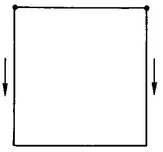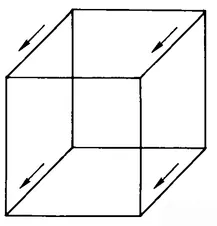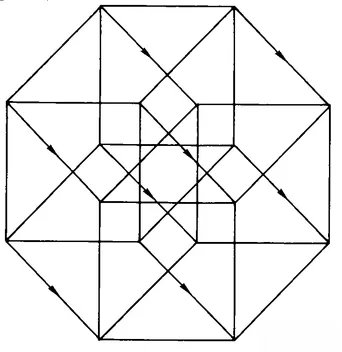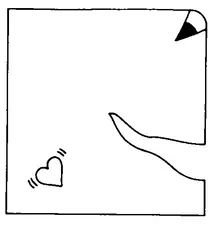![]()
1
THE FOURTH DIMENSION
We live in three-dimensional space. That is, motion in our space has three degrees of freedom—no fewer and no more. In other words, we have three mutually perpendicular types of motion (left/right, forward /backward, up/down), and any point in our space can be reached by combining the three possible types of motion (e.g., “Walk straight ahead about 200 paces to the river, then go right about 50 paces until you come to a big oak tree. Climb about 40 feet up it. I’ll be waiting for you there.”). Normally it is difficult for us to perform up/down motions; space is more three-dimensional for a bird or a fish than it is for us. On the other hand, space is essentially one-dimensional for a car driving down a two-lane road, essentially two-dimensional for a snowmobile or a car driving around an empty parking lot.
How could there be a fourth dimension, a direction perpendicular to every direction that we can indicate in our three-dimensional space? In order to get a better understanding of what a “fourth dimension” might mean, consider the following sequence:
We take a 0-D point (Figure 1; from now on, we’ll abbreviate “n-dimensional” by “n-D”), move the point one unit to the right (this produces a 1-D line segment, Figure 2), move this segment one unit downward (this, with the lines connecting the old and new segments, produces a 2-D square, Figure 3) and move the square one unit forward out of the paper to produce a 3-D cube (Figure 4).
Notice that we cannot actually draw a 3-D cube on this 2-D sheet of paper. We represent the third dimension by a line that is diagonal (rather than perpendicular) to the left/right and up/down dimensions. Now, we don’t really know anything yet about the fourth dimension, but couldn’t we try representing it by a direction on the paper that is perpendicular to the (diagonal) direction we used to represent the third dimension?
If we do so, we can continue our sequence by moving the cube one unit in the direction of the fourth dimension, producing a 4-D hypercube (Figure 5).
This design for the hypercube is taken from a little 1913 book, A Primer of Higher Space, by Claude Bragdon, an architect who incorporated this and other 4-D designs into such structures as the Rochester Chamber of Commerce Building.
It is also possible to consider a similar sequence of spheres of various dimensions. A sphere is given by its center and its radius; thus the sphere with center 0 and radius 1 is the set of all points P such that the distance between 0 and P is 1. This definition is independent of the number of dimensions your space has. There is no such thing as a 0-D sphere of radius 1, since a 0-D space has only one point. A 1-D sphere of radius 1 around 0 consists of two points (Figure 6).
A 2-D sphere of radius 1 can be represented by this figure in the xy-plane (Figure 7).
A 3-D sphere of radius 1 in the xyz coordinate system looks like Figure 8.
Although, reasoning by analogy, a 4-D sphere (hypersphere) can be seen to be the set of quadruples (x, y, z, t) such that x2 + y2 + z2 + t2 = 1 in the xyzt coordinate system, we cannot say that we have a very good mental image of the hypersphere. Interestingly, mathematical analysis does not require an image, and we can actually use calculus to find out how much 4-D space is inside a hypersphere of a given radius r.
The 1-D space inside a 1-D sphere of radius r is the length 2r.
The 2-D space inside a 2-D sphere of radius r is the area πr2.
The 3-D space inside a 3-D sphere of radius r is the volume 4/3 πr3.
The 4-D space inside a 4-D sphere of radius r is the hypervolume 1/2 π2r4.
One of the most effective methods for imagining the fourth dimension is the method of analogy. That is, in trying to imagine how 4-D objects might appear to us, it is a great help to consider the analogous efforts of a 2-D being to imagine how 3-D objects might appear to him. The 2-D being whose efforts we will consider is named A. Square (Figure 9) and he lives in Flatland.
A. Square first appeared in the book Flatland, written by Edwin A. Abbott around 1884. It is not clear if Abbott was actually the originator of this method of developing our intuition of the fourth dimension; Plato’s allegory of the cave can be seen as prefiguring the concept of Flatland.
A. Square can move up/down or left/right or in any combination of these two types of motion, but he can never move out of the plane of this sheet of paper. He is completely oblivious of the existence of any dimensions other than the two he knows, and when A. Sphere shows up one night to turn A. Square on to the third dimension, he has a rough time.
The first thing A. Sphere tried was to simply move right through the space in A. Square’s study. When A. Sphere first came into contact with the 2-D section of his 3-D space which was Flatland, A. Square saw a point (Figure 10). As A. Sphere continued his motion the point grew into a small circle (Figure 11). Which became larger (Figure 12). And then smaller (Figure 13). And finally shrank back to a point (Figure 14), which disappeared.
A. Square’s interpretation of this strange apparition was, “He must be no Circle at all, but some extremely clever juggler.” And what would you say if you heard a spectral voice proclaim, “I am A. Hypersphere. I would teach you of the fourth dimension, and to that end I will now pass through your space,” and if you then saw a point appear which slowly inflated into a good-sized sphere which then shrank back to a point, which winked mockingly out of existence. We can compare A. Square’s experience and yours by putting them in comic-strip form, one above the other (Figure 15).
The difference between the two ex...









